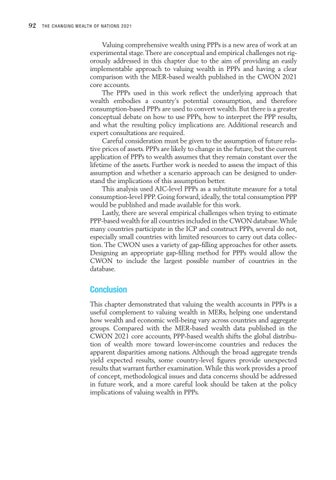92
T H E C H A N G I N G W E A LTH O F N ATIO N S 2021
Valuing comprehensive wealth using PPPs is a new area of work at an experimental stage. There are conceptual and empirical challenges not rigorously addressed in this chapter due to the aim of providing an easily implementable approach to valuing wealth in PPPs and having a clear comparison with the MER-based wealth published in the CWON 2021 core accounts. The PPPs used in this work reflect the underlying approach that wealth embodies a country’s potential consumption, and therefore consumption-based PPPs are used to convert wealth. But there is a greater conceptual debate on how to use PPPs, how to interpret the PPP results, and what the resulting policy implications are. Additional research and expert consultations are required. Careful consideration must be given to the assumption of future relative prices of assets. PPPs are likely to change in the future, but the current application of PPPs to wealth assumes that they remain constant over the lifetime of the assets. Further work is needed to assess the impact of this assumption and whether a scenario approach can be designed to understand the implications of this assumption better. This analysis used AIC-level PPPs as a substitute measure for a total consumption-level PPP. Going forward, ideally, the total consumption PPP would be published and made available for this work. Lastly, there are several empirical challenges when trying to estimate PPP-based wealth for all countries included in the CWON database. While many countries participate in the ICP and construct PPPs, several do not, especially small countries with limited resources to carry out data collection. The CWON uses a variety of gap-filling approaches for other assets. Designing an appropriate gap-filling method for PPPs would allow the CWON to include the largest possible number of countries in the database.
Conclusion This chapter demonstrated that valuing the wealth accounts in PPPs is a useful complement to valuing wealth in MERs, helping one understand how wealth and economic well-being vary across countries and aggregate groups. Compared with the MER-based wealth data published in the CWON 2021 core accounts, PPP-based wealth shifts the global distribution of wealth more toward lower-income countries and reduces the apparent disparities among nations. Although the broad aggregate trends yield expected results, some country-level figures provide unexpected results that warrant further examination. While this work provides a proof of concept, methodological issues and data concerns should be addressed in future work, and a more careful look should be taken at the policy implications of valuing wealth in PPPs.


